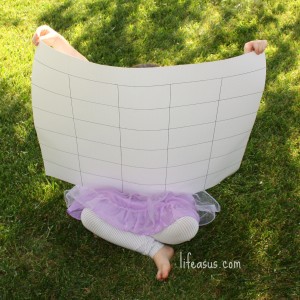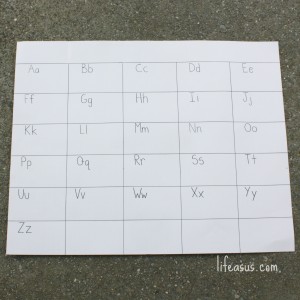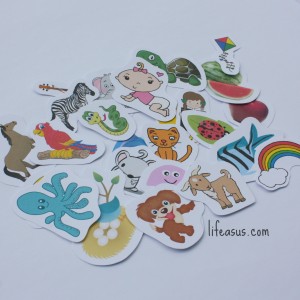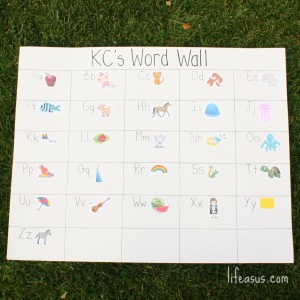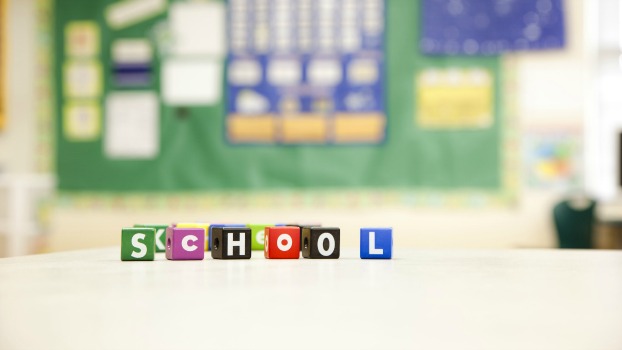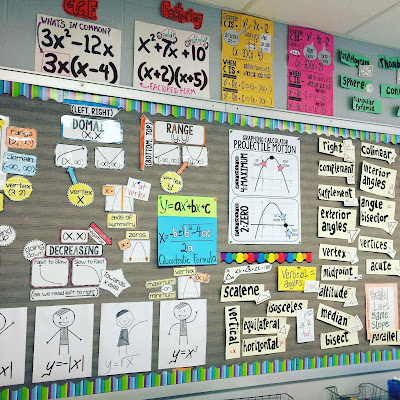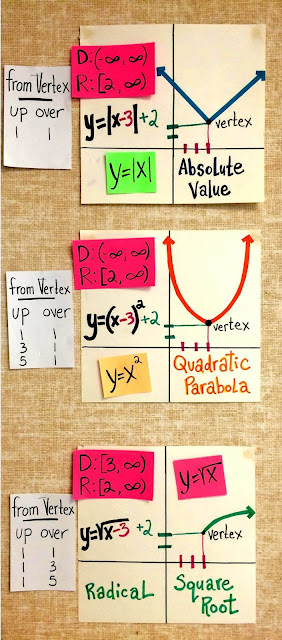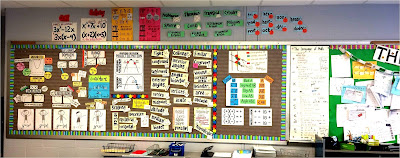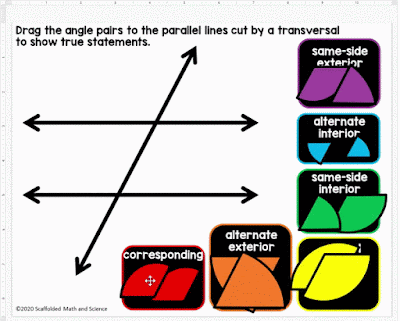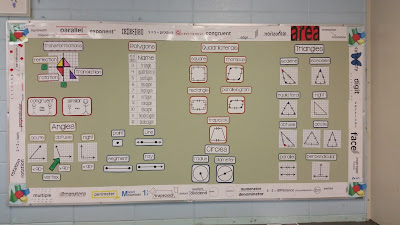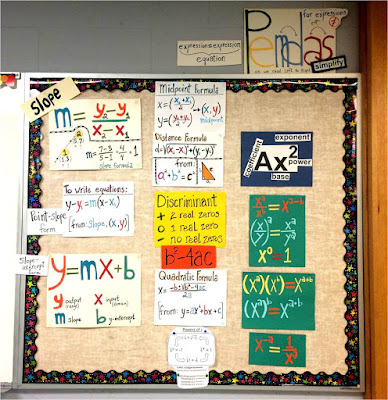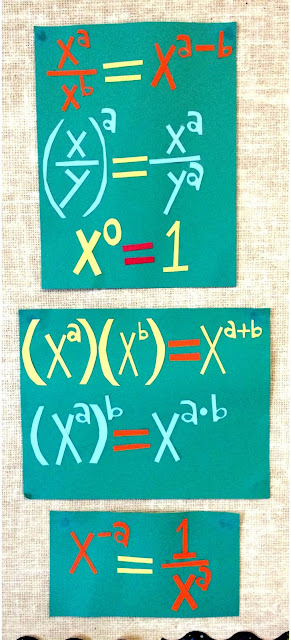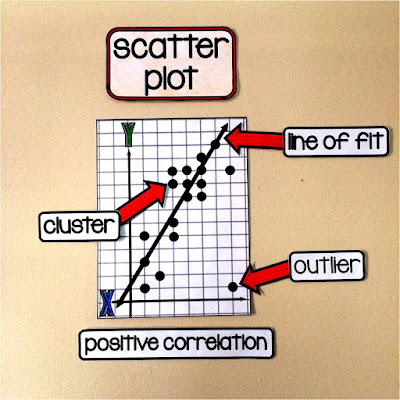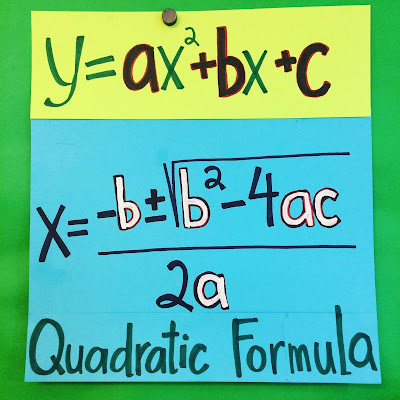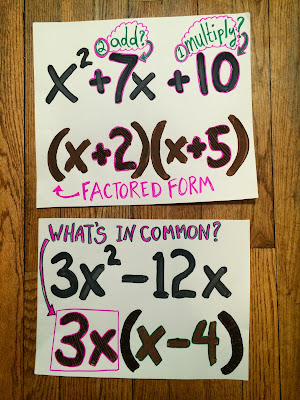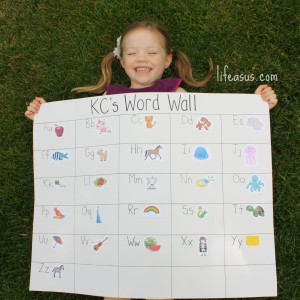
My daughter, KC, knows how to read the words “go, to, the, look, at, in, and my” so those words will be the first to go on “KC’s Word Wall” (but not immediately). Your child’s Word Wall will continue to grow as they learn more sight words. It’s a great idea to include your child in the creation of their ABC Word Wall. My daughter said, “But mom, I don’t need a ‘Word Wall’ because I already have gold dots on my wall!” Good point, KC! So this is how I explained what a “Word Wall” is to my daughter.
“I am making a chart with a box for every letter of the alphabet just like in the ABC song. I will put the letters in order (capital and lower case) going across and when I run out of room, I will go down to the next row. When I am done writing each letter of the alphabet, we will need a picture for each box that starts with that letter.”
How to make a Word Wall with your child
- Take a poster board (I found a 3 pack of white poster board size 22 inches x 28 inches at Joanne’s Fabric) or a large sheet of paper (minimum 17-1/2 or 18 X 22 inches) and mark off 5 squares across and 6 squares down (30 squares total), giving enough space in each square to write a lot of words over time. On my large poster board, my 5 squares across measured 5-10/16 in. (5.625 inches) and my 6 squares down measured 3-4/16 in. (3.25 inches). This almost worked out perfectly, and also left me about 2-1/2 inches at the top for a title to our Word Wall. Tip: Leave room at the very top to label it “[Your child’s name]’s Word Wall”. Use pencil and then marker pen to line off the squares. My post board already had a grid on it which helped to make the straight lines.
- This starts out as an alphabet chart. Title the top space of each square with 1 uppercase and 1 lower case alphabet letter going across, from Aa to Zz.
- Find 1 picture/clip art for each letter. A helpful technique when including your child as your pick your pictures is to focus on just a handful of letters with them, choose a few pictures that you think are appropriate in advance and then ask your child to pick the 1 they like best. Tip: Be sure to choose pictures for the vowels yourself. You don’t want a picture of an acorn for the letter “a” but rather the short “a” sound. Also, have fun choosing pictures that mean something to your child. We picked a picture of a parrot for the letter Pp since we have 2 pet parrots, watermelon for Ww because it’s her favorite food, and Queen Elsa of course for the letter Qq!
- Cut out and paste each picture next to the letter (or right below the letter). This is what alphabet charts in classrooms look like! For reference, the pictures used on most ABC charts are: apple, ball, cat, dog, elephant, fish, goat, horse, insect, jack-in-the-box, kite, lion, mouse, nest, octopus, pencil, queen, ring, snake, tiger, umbrella, violin, watch, x-ray, yellow, zebra.
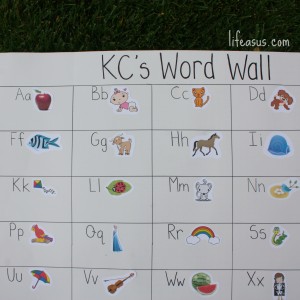
I do not claim any of this clip art as my own. I found it all on the internet and did my best to only choose free images. I am not using these images to make money, and I hope that you will not either.
Aa, Bb (25%), Cc, Dd, Ee, Ff, Gg, Hh (30%), Ii, Jj (25%), Kk, Ll, Mm, Nn (20%, print “orientation” as horizontal), Oo (25%), Pp (20%), Qq (35%, only print 1st page), Rr, Ss, Tt (30%), Uu, Vv, Ww, Xx (40%), Yy, Zz (20%)
How to model/practice the Word Wall with your child
- Point below the letter and picture for A, a, apple as you say/read what you are pointing to. Be sure to have a conversation about why each picture is in a particular box. For example, “An ‘apple’ in the Aa box because when I say ‘apple’, I feel my mouth make the ‘a’ sound like the letter Aa. A makes the ‘a’ sound.”
- Have your child try it.
- Go to Bb ball and repeat steps 1 and 2.
- After completing steps 1 and 2 for the 1st row of letters, you will now model the entire 2nd row at once the same way as step 1.
- Have your child try the entire 2nd row.
- Repeat steps 4 and 5 for each row until you’ve completed the entire alphabet Tip: You will be able to tell if you can do the whole chart or 1/2 the chart in 1 sitting.
Tip: We suggest hanging your Word Wall in your child’s room so that it can be reviewed every night before bedtime.
I know that this looks like a lot of work right now, but it will pay off big time! This is one of the first activities teachers start with daily in Kindergarten. Send us pictures of your Word Wall and we will try to feature them all on our blog! – lifeasallison

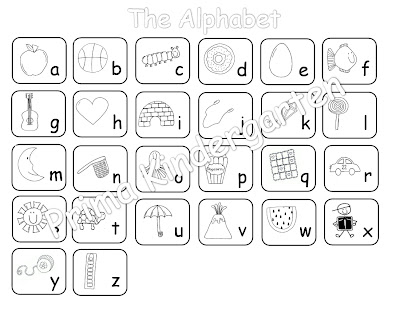
Our first graders receive resource binders to keep in their “seat sacks.” These binders include reference pages for math (120 chart, number word page), literacy, and more. It’s similar to a “mini-office” except that it’s in a binder format. Every student receives a “personal word wall” page with sight words, plus a blank word wall to fill in throughout the year:
The above picture shows both pages (we print them double-sided). To read more about the resource binders and pick up your own word wall copy, please click here!
Happy Teaching!
Positively Learning
If you have always wanted to have a word wall in your classroom, but were not sure how to begin, we can help. Word walls or displays are a great way to encourage vocabulary development and reinforce language skills. Whether you have an entire wall or a simple pocket chart to devote to it, a word wall can work in any classroom. Try the tricks below to get you started this school year!
Word Wall Basics
Cumulative vs. Work in Progress
Contrary to what some may believe, word walls are not cumulative displays of words learned throughout the year. Instead, they are a place to store new vocabulary from current lessons. Take key vocabulary words from stories being read, history lessons being taught and science experiments being conducted and place them on the word wall. As the lessons and stories change, so too should the words on display. Do not feel locked into having the same words displayed all year long, as that is not the true purpose of a class word wall.
Upon Mastery
Once words have been mastered, they can be transferred to a either a cumulative vocabulary board or placed in a file box word bank. Students should also have a record of the words that were displayed, either in a word journal or in their own file box word bank. Some teachers then use the past words for games of Bingo or other brain teasers. You can also pull words and use them as creative story starters for morning writing.
Materials Needed
Word walls can be as simple or as complex as you make them. For the simplest word wall, use a sentence strip pocket chart where you can cut the words to size, slip them into the pockets and display it at the front of the class. If you have more wall space for displays, place the letters of the alphabet in a row and display the current word wall words below the corresponding letters. If there is no board space or wall space available, hang a clothesline across the room and clothespin the words to the line. Write the words on brightly colored sentence strips or on large, pre-made shapes. Make sure that the words are so clearly written that students can see them from across the room.
Do you use a word wall in your classroom? What do you find to be the most effective way to introduce new vocabulary to your students?
Share your ideas below or on the Really Good Teachers Forums! We’d love to hear how you do it!
When I taught math in Boston my classroom was next to a Geometry teacher who had a math word wall that spread just about floor to ceiling. At the time I thought it was a bit extreme. I mean, aren’t high school kids a little old for so many visuals? Did they really need all that?
Well, my teacher neighbor went on to become Teacher of the Year and I went on to realize how powerful math word walls are — especially those that show math vocabulary in context.
Before landing that first full-time teaching job, I was a substitute teacher for a year. I’ll never forget a job I took in a kindergarten class. The letter of the day was K. Some kids could write «kite», «kat» (English is so weird), while other kids couldn’t even write a K.
The discrepancy in abilities I saw that day in kids so young completely blew my mind. If there was such a large span of abilities in five year olds, what about in 15, 16, 17, 18 year olds? And how would I reach them?
In all of our classrooms there is a wide range of abilities. Some kids are above grade level while others may be years behind. What I like the most about math word walls is that they are always there offering information to students who need it.
Whether they are too shy to ask a question or need a quick reminder, or maybe they have a hard time concentrating so do a lot of looking around the room. While they are glancing around, maybe they’ll learn something new. Word walls allow kids to access the curriculum at their level and continue to offer support every day. I write more about this in the post 5 Ways Math Word Walls Have Changed My Teaching.
In this post I’ll share photos of my own classroom’s word walls (like the photo at the top) as well as photos of word walls I have made for teachers by request. This post is linked in 8 Out-of-the-Box Ideas for Teaching Algebra and Geometry on the We Are Teachers blog.
I also recently updated all of my high school math word walls with no-prep digital versions built in Google Slides.
They are clickable in GOOGLE Slides or can be downloaded as PowerPoint or PDF files and still be interactive. Above is the home screen of a digital algebra 2 word wall. Each image clicks to an enlarged version. The word wall is also included as print color and print black and white.
My teacher back in Boston neighbor was absolutely right in putting it all out there like that. If you think about it, there’s a measly 5 year age difference between a 4th grader and a 9th grader. Yes, kids do grow quick, but what is it about those 5 short years that suddenly allows students to remember and recall everything and no longer need visual reminders?
 |
| part of an Algebra 2 Word Wall |
When my husband moved from teaching elementary school to high school he was a little worried. I told him that high schoolers are just little kids in big bodies. It’s true! They still need the support of word walls as much as the little ones do.
For me, adding math classroom decor to my walls not only made my classroom a more inviting place to learn, it also made it one giant reference sheet. This immediately lowered my students’ anxiety levels to where memorization and past misconceptions were no longer sticking points.
Since starting at my current school, I have taught Geometry, Biology, Consumer Math and Algebra 2. Since Algebra 1 is so important, we have references for it too. Here are some photos of the word walls in my classroom.
Here you can see an anchor chart for drawing and naming points, lines and segments. I made the parallel lines cut by a transversal poster below it from cut paper.
| Free parallel lines cut by a transversal poster |
This parallel lines cut by a transversal poster was one I made for a class of sophomore study skills students who were taking Geometry. Many of them were mixing up the angle pairs. So I made this poster for them to put in their notebooks (above is the enlarged version).
I also converted it to work on GOOGLE Slides as a digital angle pairs poster.
I recently made a Geometry word wall and a super sweet teacher sent me this photo of it hanging in her classroom. Here is my own photo of some of the included parts up close:
 |
| part of a Geometry Word Wall |
Here is a closeup of the transformations section:
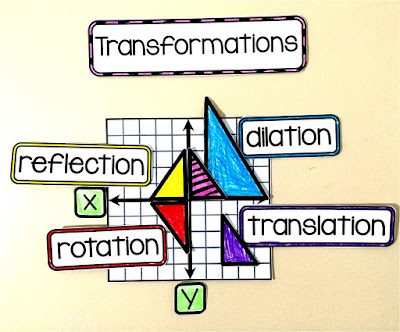 |
| part of a Geometry Word Wall |
Next up is our wall of Algebra, Geometry and Algebra 2 formulas. I like to think of this wall as «the hodgepodge», though I have since updated most of my math word walls.
The PEMDAS, slope formula, y=mx+b, and green exponents posters are all also made from cut colored paper like the angle pairs poster in the previous photo. Here’s a close up of the exponents posters:
This exponent rules posters is made out of cut paper too. I added exponent rules into my 8th grade math word wall. Here is a photo of some of the graphing references included. You can also see all of the middle school math word walls I have made in the post Middle School Math Word Wall Ideas.
An scatter plots:
This PEMDAS mobile was a recent addition.
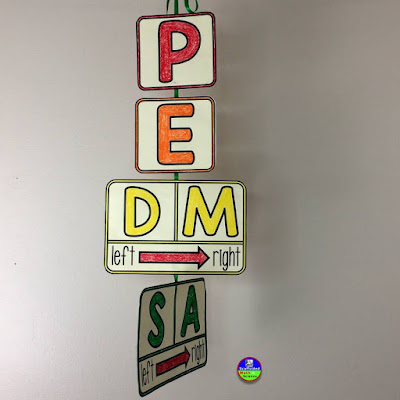 |
| Free PEMDAS mobile |
Our Algebra 2 word wall has grown a lot over the years. Teachers have asked me to make parent graphs for nonlinear functions and also expand the word wall in other areas. It’s gone through a lot of updates! 
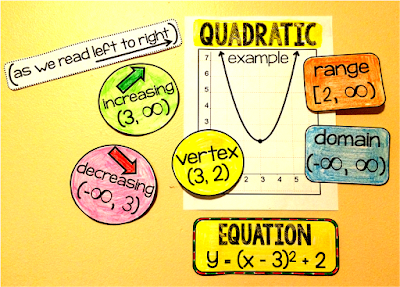 |
| part of an Algebra 2 Word Wall |
And of course we need a Quadratic Formula anchor chart. My students were able to use this one a lot more effectively once I added the white-out to the a, b and c in the formula. You can read more about our quadratics activities in the post Fun with Quadratics.
We teach a lot of vertex form in Algebra 2 so we reference these 3 anchor charts on our Algebra 2 word wall for nonlinear equations all year. These are updated printable versions of cut paper versions I finally retired this year. It was time.
 |
| part of an Algebra 2 Word Wall |
I love catching students glancing at our word walls for hints. To me, knowing how to access information is just as important as the information itself. Every year I add more and more to our classroom word walls. The more I add, the better things get.
One of the free quadratics math posters that worked especially well during our combined graphing calculator/projectile motion unit — a unit that is VERY hard at first for my students — was this one.
It shows good cursor placements for finding maximum points and zeros. My students get confused by «left bound» and «right bound» and this poster all but completely eliminates this confusion.
These factoring anchor charts hang in my room to remind my students how to factor trinomials and binomials. I always find my students have a harder time retaining how to factor binomials than trinomials!
In an earlier post I wrote about our classroom Fridge, an area in our classroom where students are invited to display their hard work. I am always surprised that even my seniors would rather hang their work in our classroom than take it home. Math pennants are another fun way to display student work. See more math pennants.
Having a language of math poster has helped so much, especially for those small but powerful words like «of» and «is». When kids start seeing Math as a language that can be translated into symbols… WHOA watch out World! 
With references on the walls I feel like a better teacher and my students feel less anxious and more confident in their ability to do hard math. The more I add to my classroom walls the more empowered my students feel and become.
Math word wall downloads:
◉ Unit Circle Word Wall

